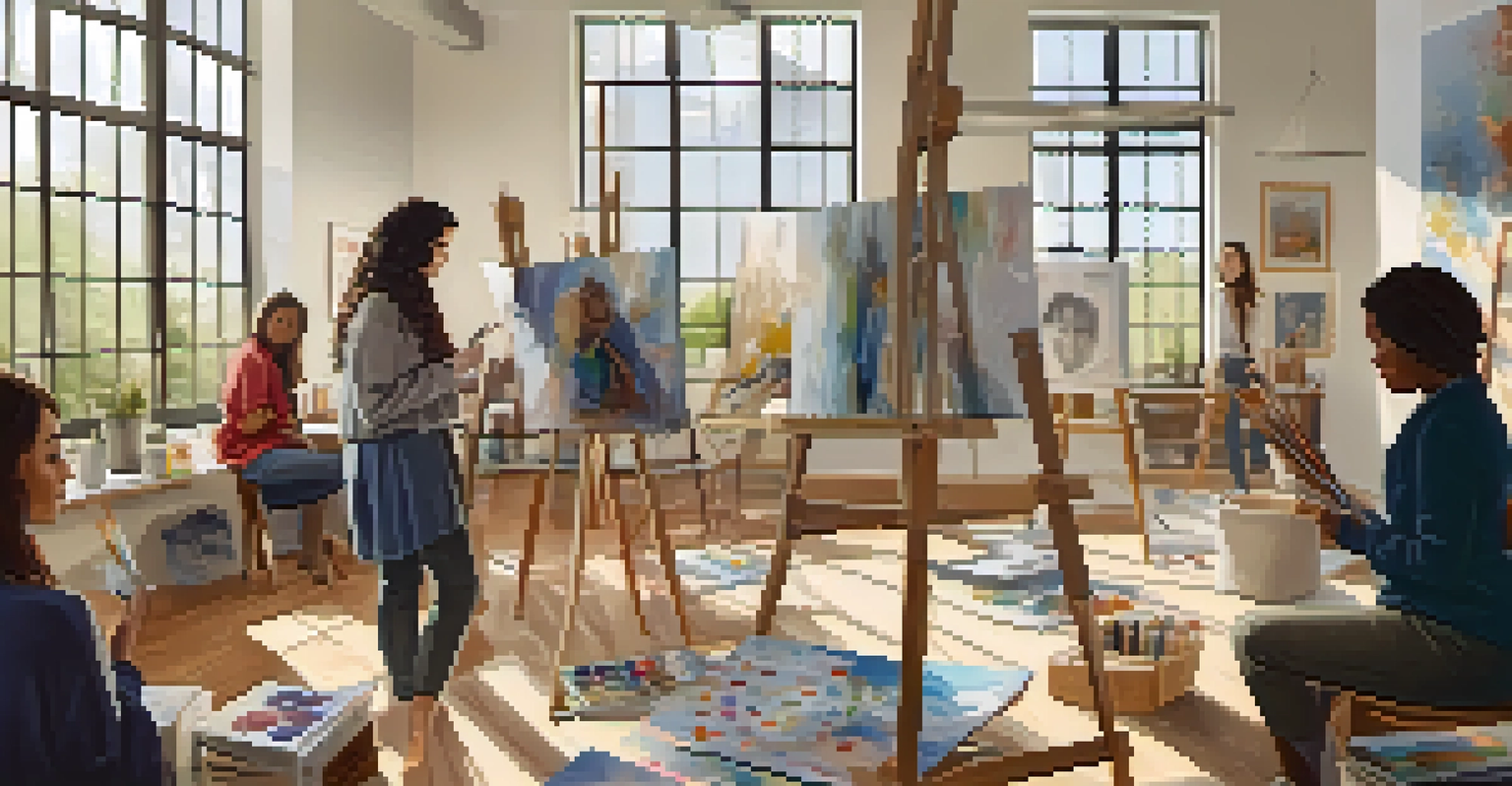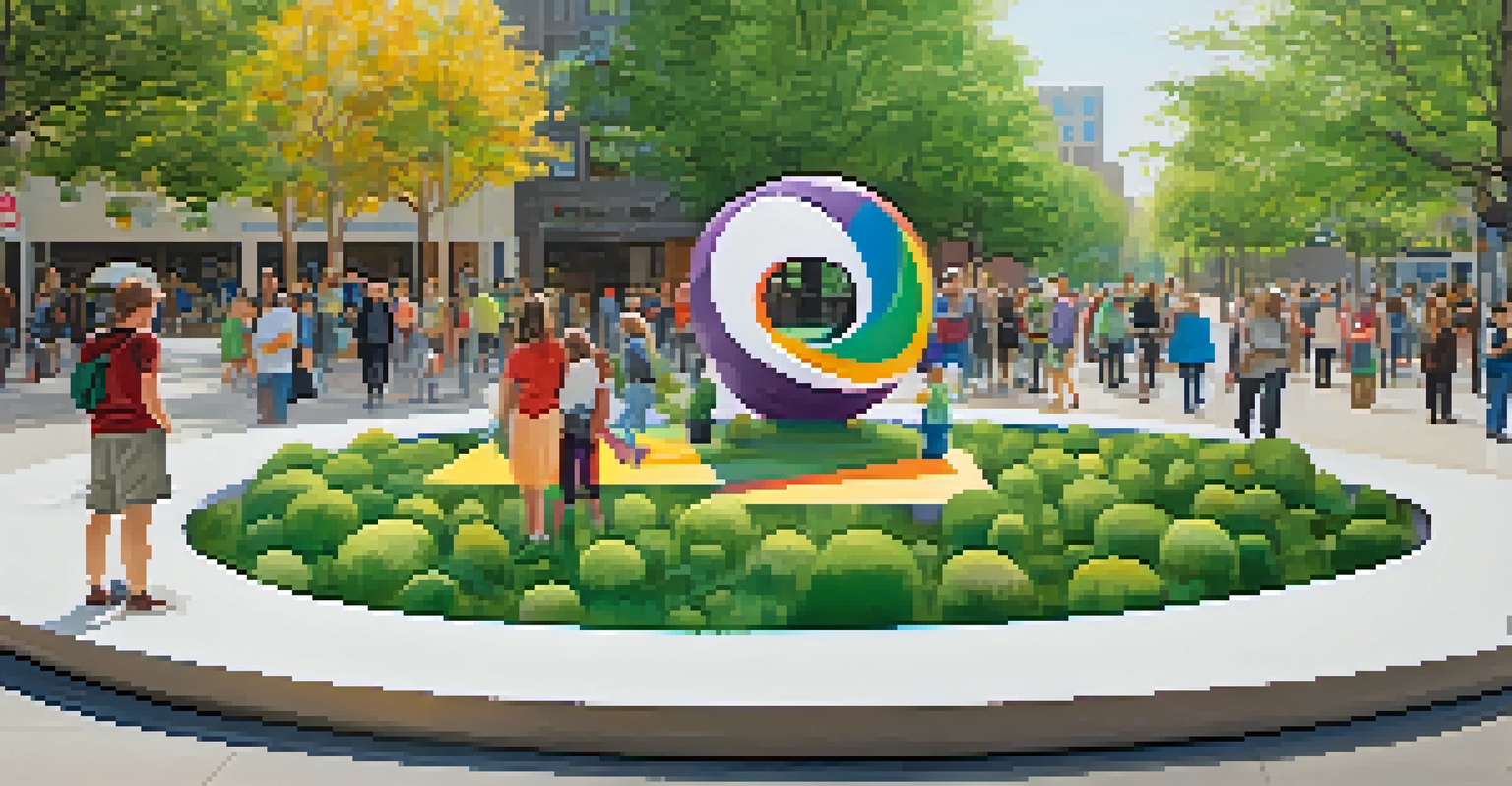Integrating Art into Community Health Initiatives

The Role of Art in Enhancing Community Well-Being
Art has a unique ability to bring people together, fostering a sense of community and shared purpose. When integrated into health initiatives, it can create an environment that promotes emotional and mental well-being. For instance, community mural projects not only beautify spaces but also encourage collaboration and pride among residents.
Art is the most beautiful of all lies.
These artistic endeavors often serve as a catalyst for discussions about health issues, making them more relatable and accessible. By connecting people through creativity, art helps to break down barriers that might exist in traditional healthcare settings. This synergy can lead to improved health outcomes and a more engaged community.
Moreover, art can be therapeutic in nature. Activities like painting, dancing, or music can reduce stress and anxiety, providing a much-needed outlet for self-expression. In this way, art becomes not just a medium of communication but a vital tool for emotional healing and resilience.
Case Studies: Successful Integration of Art and Health
Several communities have successfully integrated art into their health initiatives, showcasing its impact firsthand. For example, a health clinic in California began offering art therapy sessions for patients dealing with chronic illness. This approach not only helped patients process their emotions but also created a supportive network among them.

Another inspiring case is the 'Art for Health' program in the UK, where artists collaborate with healthcare professionals to design creative workshops aimed at improving mental health. Participants report feeling less isolated and more empowered as they engage in artistic activities that resonate with their personal experiences.
Art Fosters Community Engagement
Integrating art into health initiatives brings people together, enhancing collaboration and community pride.
These examples highlight the versatility of art in addressing various health challenges. By tailoring artistic programs to fit the specific needs of a community, organizations can foster a more holistic approach to health that values creativity alongside traditional medical practices.
Understanding the Psychological Benefits of Art
Art is not just about aesthetics; it has profound psychological benefits that can enhance overall health. Engaging in creative activities stimulates the brain, leading to the release of endorphins, which promote feelings of happiness and well-being. This biological response can be particularly beneficial in community health settings, where individuals may face stress or trauma.
The arts are not a way to make a living. They are a very human way of making life more bearable.
Furthermore, art encourages mindfulness—a state of being present that can help reduce anxiety and depression. When individuals immerse themselves in a creative process, they often find a temporary escape from their worries. This practice can lead to improved mental clarity and emotional resilience.
As communities begin to recognize the therapeutic potential of art, integrating it into public health strategies becomes increasingly important. It offers a non-invasive, accessible means for people to explore their feelings and connect with others, ultimately leading to healthier communities.
Collaborating with Local Artists and Organizations
Successful integration of art in health initiatives often involves collaboration with local artists and organizations. By tapping into the creative talents within a community, health programs can ensure that their initiatives are culturally relevant and resonate with the audience. This grassroots approach fosters ownership and investment in the programs.
Local artists bring unique perspectives and skills that can enhance the effectiveness of health campaigns. For instance, they can design workshops that cater to specific demographics, ensuring that everyone feels included and represented. This not only enriches the community but also enhances the overall success of health initiatives.
Art Enhances Mental Well-Being
Creative activities like painting and music serve as therapeutic outlets, reducing stress and promoting emotional healing.
Additionally, partnerships with non-profits or arts organizations can provide valuable resources and expertise. These collaborations can lead to innovative projects that not only address health concerns but also encourage community engagement and artistic exploration.
Art as a Medium for Raising Health Awareness
Art can serve as a powerful tool for raising awareness about health issues that affect communities. Through compelling visuals or performances, artists can communicate messages that resonate on a personal level, making complex health topics more approachable. For example, a public art installation about mental health can spark dialogue and reduce stigma.
By utilizing various forms of art—such as theater, music, or visual arts—communities are able to reach a wider audience. These creative expressions can captivate attention and inspire action, leading to increased participation in health programs and initiatives. It's about creating a narrative that people can connect with.
Moreover, art-driven campaigns can be easily shared across social media platforms, amplifying their reach. When health messages are wrapped in creativity, they have the potential to go viral, spreading awareness beyond the local community and fostering a larger conversation around health.
Challenges in Integrating Art into Health Programs
While the benefits of integrating art into health initiatives are clear, there are challenges that must be navigated. One significant hurdle is securing funding for these programs, as many health organizations operate under tight budgets. Art projects often require additional resources for materials, artist fees, and promotion, which can complicate their implementation.
Another challenge is measuring the impact of art on health outcomes. Unlike traditional medical interventions, the benefits of art can be more subjective and harder to quantify. Developing appropriate metrics to assess the effectiveness of these initiatives is essential for justifying their value to stakeholders and securing ongoing support.
Collaborative Approaches Are Key
Partnering with local artists and organizations ensures that art programs are culturally relevant and inclusive, boosting their effectiveness.
Lastly, ensuring that art programs are inclusive and accessible to all community members is crucial. Barriers such as language, economic status, or physical ability can limit participation, so it's vital for organizers to create environments that welcome everyone. This inclusivity not only enriches the programs but also enhances community cohesion.
Future Directions: Expanding Art-Health Collaborations
Looking ahead, the future of art in community health initiatives appears promising. As more evidence emerges highlighting the positive impact of art on well-being, organizations are likely to invest in integrating these creative approaches into their programs. This shift could lead to a more holistic understanding of health that goes beyond traditional medical models.
The potential for digital art platforms also opens new avenues for engagement. Virtual workshops and online art therapy sessions can reach individuals who may not have access to in-person resources, expanding the reach of health initiatives. This adaptability ensures that art continues to play a critical role in promoting well-being in diverse settings.

Ultimately, fostering collaboration between artists, healthcare providers, and community members will be key to driving this movement forward. By embracing creativity as a vital component of health, we can cultivate healthier, happier communities that thrive on artistic expression and collective support.